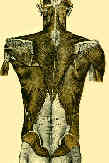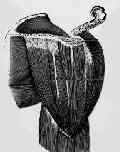- See: Shoulder Abductors

- Discussion:
- major function of the deltoid muscle is to abduct arm;
- it performs this action after scapula[scapula has been fixed by its stabilizing muscles and the humeral head has been
snubbed to glenoid by the rotator cuff;
- it is innervated by axillary nerve (C5);
- Anterior Division:
- origin: anterior border of the lateral 1/3 of the clavicle;
- insertion: deltoid tuberosity of the humerus;
- action: abduction, horizontal flexion and medial rotation of humerus at shoulder;
- nerve supply: axillary, C5, C6 ;
- synergists: medial and posterior deltoid divisions, supraspinatus and pectoralis major clavicular division;

- Deltoid: Medial Division:
- origin: superior surface of the acromion process;
- insertion: deltoid tuberosity of humerus;
- action: abduction of the humerus at the shoulder
- nerve supply: axillary, C5, C6;
- synergists: anterior and posterior deltoid divisions, supraspinatus;
- Deltoid: Posterior Division:
- origin: inferior margin of spine of scapula;
- insertion: deltoid tuberosityy of humerus;
- action: abduction, horizontal extension & lateral rotation of humerus at shoulder;
- nerve supply: axillary, C5, C6;
- synergists: anterior and medial divisions of deltoid, supraspinatus;
- Surgical approach:
- if deltoid muscle is split anteriorly for > 5 cm, branches of axillary nerve will be damaged, rendering corresponding portion of deltoid muscle deinnervated;
- however, deltoid is innervated by the axillary nerve, whose branches pass upward as they extend anteriorly & may come as close as 2 cm to acromion;
- hence, this anamatomy defies the described 5 cm safe zone;
- posteriorly: medial edge of the deltoid is too medial to provide useful access to the glenohumeral joint;
- access must be acheived by splitting deltoid, which is most conveniently done at junction of its middle & posterior thirds;
- site is favorable for a split because it overlies joint & also because axillary nerve exiting quadrangular space divides into 2 trunks
(anterior and posterior divisions) in an inferior location;
- Deltoid Contracture:
- often arises from multiple intra-muscular injections;
- clinical manifestations:
- shoulder pain, palpable fibrous band, scapular winging, difficulty in combing hair, and an abduction contracture;
- radiographs: anterosuperior subluxation of the humeral head;
- management: distal release;
- Deltoid Paralysis: (most commonly occurs from parsonage turner syndrome)
The sub-deltoid approach to the metaphyseal region of the humerus.
Contracture of the Deltoid Muscle. Results of distal release.

